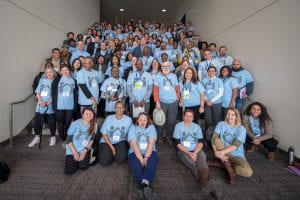
Lobby Day participants gather at the 2018 Housing California Annual Conference before heading to the state capitol for visits with legislators. Photo by Alex Matthews
In November 2018, Californians voted with the housing crisis and their values in mind when they overwhelmingly passed Propositions 1 and 2, a combined $6 billion for affordable and supportive housing for lower-income Californians and for people chronically struggling on the streets while living with mental illness. Proposition 1, the Veterans and Affordable Housing Act, received 56 percent of the vote. Proposition 2, the No Place Like Home Act, received 63 percent.
California was not alone. Voters in eight states weighed in on statewide, regional, and local housing measures. Now, the movement for affordable housing policy solutions and campaign promises that swept across states last November continues as our country enters presidential campaign season.
Presidential hopefuls including Sens. Kamala Harris (D-CA), Elizabeth Warren (D-Mass), and Cory Booker (D-NJ) have introduced housing and anti-poverty measures as core issues to their candidacies. Meanwhile, everyone is watching to see how newly elected governor Gavin Newsom delivers on his promise to build 3.5 million homes by 2025.
Interest from voters in affordable housing and homelessness solutions remains high, especially in California, which, despite having one of the world’s wealthiest economies, continues to hold the unfortunate lead for highest poverty rate and most residents experiencing homelessness on any given night in America. The latest Quinnipiac University Poll, released Feb. 6, reported that 77 percent of California voters say we are in a “housing crisis,” and 61 percent of 18- to 34-year-old state voters say they can’t afford to live in the state.
As housing grows to be ever more urgent an issue—and we grow ever more politically ready to take it on—California’s unique model for running a statewide campaign that relied on regional coordination and the voices of the people most impacted offers relevant insights to organizations around the nation. Offering views from statewide to regional, and spanning varied political climates and cultural contexts, here are our unique strategies and tactics from what became known as “The Year of Affordable Housing” in California’s 2018 election cycle.
The State
Contributor: Nur Kausar, Housing California
Housing California, the voice in the State Capitol for ending homelessness and for everyone who needs a safe, stable, affordable home, co-led the full Propositions 1 and 2 campaign at the state level with three other organizations. Housing California also manages the Residents United Network with national organization Community Change, engaging residents, nonprofit developers, and staff of affordable housing to use their powerful voices to become advocates.
The path to ballot success came with interesting circumstances and challenges that required a highly coordinated multi-sector, multi-regional effort. For one, California is home to more than 25 million registered voters spread across a diverse geography, each region with its own unique political climate. Second, the California Legislature placed both propositions on the ballot through legislative action, so a public campaign for these specific investments needed to be created from scratch and pushed out quickly, unlike campaigns that may have started with a public signature-gathering and education process.
At the heart of the Propositions 1 and 2 campaign sat the state-level partners—four organizations that advocated the legislature to run the propositions, worked with the state on ballot language, and spearheaded high-level coordination and fundraising: Housing California, California Housing Consortium, State Building Trades of California, and Silicon Valley Leadership Group. This statewide Props 1 and 2 team took on the tasks of hiring consultants, approving materials, securing major donors, and pumping relevant and cohesive information to each major regional artery that then branched out to local communities. This was done by creating four committees: Executive, Advisory, Fundraising, and Coalition and Communications – all of which included key allies and legislative leaders.
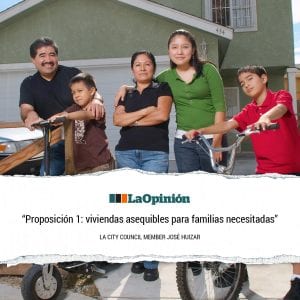
As a small campaign, we knew we needed a grassroots effort as well. Our campaign team generated and pushed out weekly or biweekly toolkits of digital content beginning midsummer and lasting throughout the campaign, and the team worked hard to leverage our extensive, broad-based coalition to talk to a grassroots base of progressive and younger voters, younger Democrats, renters and affordable housing residents, using mostly “sweat equity” from our regional coalition partners and their grassroots organizations.
Finally, we benefited from help from allies in the state legislature and mayors who held press conferences, including Bay Area mayors Libby Schaaf, London Breed, and Sam Liccardo, and who created their own video spots and raised money to run them. Assembly members used their own committee resources to put out direct mail pieces about Props 1 and 2, and the state Democratic Party included them on at least 3 million mailers and slate cards plus 1 million door hangers and a dedicated email blast.
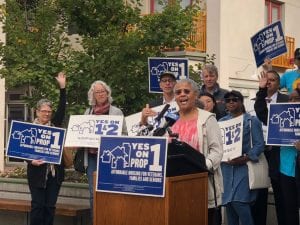
EBHO Board President and affordable housing resident Sister Marie Taylor speaks at Prop 1&2 rally in Oakland, California.
The designated coalition and its communications committee, made up of the campaign manager, consultants, and state and regional advocacy staff, worked to secure several editorial endorsements and op-eds, six press conferences, and multi-sector spokespersons. This encouraged regions to use their capacity and local expertise to run the campaign from their respective locations, and the committee provided the technical support and latest information from ongoing polling and focus groups to stay on message.
Regional partners included affordable housing advocacy groups, tenants’ rights groups, affordable housing developers, labor unions, business groups, elected officials and more. Together, they helped to secure endorsements, media, spokespeople, and ultimately, the necessary votes for the win.
Bay Area
Contributor: Alina Harway, The Nonprofit Housing Association of Northern California (NPH)
NPH led a coalition of 10 organizations across 11 Greater Bay Area counties to coordinate community and press outreach efforts. Together they were able to collect over 400 endorsements from local political leaders, community organizations, and activists. NPH coordinated endorsements from six local press outlets, and represented the campaign at community events, gatherings and organization meetings.
The San Francisco Bay Area region, which covers nine counties, 101 cities and more than seven million people, was among the first parts of the state to be hit hard by the lack of affordable housing and the rising costs of rent.
This deeply felt crisis in the region gave the Bay Area a head start in building infrastructure. Initiating a groundbreaking new electoral strategy, Bay Area advocates led local county ballot measure campaigns in 2015 and 2016. As the regional voice of affordable housing for the Bay Area, the Non-Profit Housing Association of Northern California (NPH) galvanized our Bay Area members, partners, advocates, and campaign leaders to initiate, support, and pass the affordable housing revenue measures and ensured that the partnerships and work sustained beyond 2015 and 2016. Our network maintained – and continued to grow – critical relationships, increased capacity of local organizers, and shared a narrative around the housing crisis that resonated with voters well beyond the local ballot work.
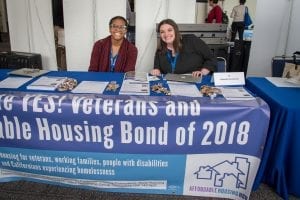
Housing California Conference 2018
And this allowed us to mobilize our networks and coalitions right away for 2018; we saw firsthand how our coalitions were ready to engage sooner and more heavily this election cycle because they had been through this type of work with us once before. NPH activated our Bay Area communications collaboratives to leverage the Prop 1 and Prop 2 content, using our collective email and social media to reach more than 88,000 supporters directly. We grew our fundraising program, having demonstrated the value to our donor network already (in 2016, we raised $2 million and secured $2.1 billion.) And we were able to quickly fold the Props 1 and 2 education and engagement content into our ongoing resident engagement programs.
We were also proud to build on these known tactics, introducing new, expanded, and improved programs and tactics for 2018.
As the regional lead for Propositions 1 and 2, NPH enhanced our speakers bureau model for media opportunities and introduced new community organizing trainings. We held nine trainings with 80 member staff and activists throughout the region in communications and organizing tactics in a “train the trainer” model that allowed their small teams to reach deep into the industry for short and long-term growth.
NPH also grew our resident engagement program, testing new direct outreach to Bay Area affordable housing residents. Working with 11 developer members to share targeted voter information across affordable housing properties, NPH distributed 19,000 slate cards in four languages and 2,000 voter registration posters in seven languages, to every county in the region. NPH sent more than 130,000 pieces of Get Out the Vote mail to a universe of 54,000 registered voters living in affordable housing communities, and employed a robust digital advertising campaign partially targeted to affordable housing residents.
In addition to the statewide Props 1 and Props 2 campaigns, NPH also assessed, identified, and supported several local Bay Area affordable housing funding measures. Leveraging statewide reach and local depth, NPH’s coordinated efforts allowed our coalition to message and reach voters on a package of affordable housing measures, demonstrating how our local and state measures together could maximize impact for our local communities. As a result, in addition to $6 billion statewide, the region passed $440 million in local funds through a number of local measures in Berkeley, San Francisco, and Napa County.
Southern California
Contributor: Jeannette Brown, The Southern California Association of Nonprofit Housing (SCANPH)
The Southern California Association of Nonprofit Housing led a steering committee of 18 member organizations across 5 counties to coordinate community and press outreach efforts, along with communications outreach to 4,000 contacts. Together we were able to collect over 200 endorsements from local political leaders, community organizations, and activists.
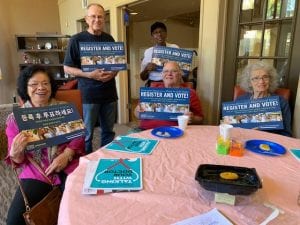
Bracher Senior Housing resident voter engagement information in multiple languages. Photo courtesy of LifeSTEPS
Los Angeles has one of the highest concentrations of poverty and homelessness. SCANPH serves the Southern California region of Los Angeles, Orange, Ventura, Riverside, and San Bernardino counties. Together, these counties represent the largest population base in California, the greatest concentration of poverty and housing need, and a vibrant mix of communities with diverse resources and approaches to providing affordable housing. There is a countywide shortage of 568,255 affordable rental homes for households earning less than $41,500 for a four-person household.
Los Angeles historically has low voter turnout and the large geographic terrain of Southern California presents challenges for mobilization of voters. While Los Angeles County has more registered voters than the nine counties that make up the Bay Area, in the last three primaries (2012, 2014, and 2016), the percentage turnout was vastly higher in the Bay Area.
Nevertheless, Los Angeles voters in recent years had already shown a strong commitment to addressing the housing crisis at the ballot. For the November 2016 ballot, SCANPH was integral in efforts to place on the ballot – and pass – inclusionary housing (Measure JJJ: 65 percent support) and $1.2 billion for permanent supportive housing (Proposition HHH: 77 percent support).
In 2017, SCANPH played major roles in passing a countywide sales tax (Measure H) to raise funds for homelessness services to complement the capital funds (Proposition HHH), and defeating a slow growth measure that would have stalled affordable housing development (Measure S).
Investments made by policymakers and voters in Los Angeles County continue to show broad support for local solutions and funding increases to address housing and homelessness. This established momentum for Props 1 and 2.
Props 1 and 2 campaign tactics included local fundraising, voter outreach, coalition building, and grassroots organizing. SCANPH established a steering committee of top-level executives from 18 major member organizations tasked with fundraising support, as each organization had to make a commitment to contribute and help identify new prospects for outreach.
Attracting media attention for voter recognition of the campaign’s message was greatly strengthened by partnering with the mayor’s office and city council members. As such, SCANPH held a successful rally and press conference in front of City Hall with Mayor Garcetti, council members, and a resident. This attracted major TV news stations, radio, and newspapers. SCANPH developed a closer relationship to the mayor and city council during a campaign to pass a linkage fee in 2017, and this relationship provided the basis for collaboration on a rally for Propositions 1 and 2.
In 2017, the Coalition for a Just Los Angeles, led by SCANPH with dozens of other groups, had been created to pass a linkage fee at LA City Council in December 2017. This successful coalition provided an established base of contacts and supporters to mobilize for the Proposition 1 and 2 campaigns. The coalition’s constituents were reliable partners for rallies and voter outreach.
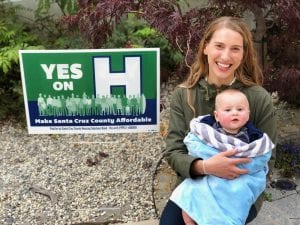
Local Bay Area supporters get ready to knock doors for local affordable housing measures.
On the grassroots level, SCANPH conducted over 50 training sessions at member developments and across Southern California to advance civic engagement. This included train-the-trainer sessions so that members received organizing training. As a result, 300 new residents registered to vote through the activities SCANPH did in the 50 properties. We estimate a 46 percent voter turnout rate at the buildings in which they were active (voter education/registration, etc.), which is significantly higher than the historic average for the county during a midterm election.
Lessons learned: The collective strength of SCANPH’s political reach is greatly amplified by member engagement via a committee framework, including a steering committee specifically for the campaign and a policy committee engaged on the substance of the measures; Southern California’s expansive geography requires consistent messaging dispersed in varied formats to reach necessary levels of magnitude; the power of storytelling, such as resident stories, has greater media resonance; voter education of residents represents an exciting opportunity to build an inclusive 21st-century democracy in the most populous region of the state and speaks to the importance of ongoing field work for future campaign work.
Inland California
Contributor: Rob Wiener, California Coalition for Rural Housing (CCRH); and Tom Collishaw, Self-Help Enterprises
The meaning of “rural” varies in California. Interior valley and mountain counties tend to be the most conservative politically and view government as untrustworthy, invasive, and inefficient—although they depend on government in many ways that are often overlooked. Coastal rural counties tend to be more liberal politically, but are faced with strong push-back from environmentalists and wealthy residents who don’t want lower-income people and people of color to live in their exclusive enclaves.
There is also a congenital belief that rural areas don’t get their fair share of state funding resources, so voters may not see the point of supporting these programs on the state ballot or in the state legislature.
The San Joaquin Valley is the reddest part of the bluest state in the nation, with a political environment more akin to Montana than San Francisco. Bond funding, which is what Props 1 and 2 offer, is not much better than taxation from a local conservative perspective—both are viewed as “mortgaging our future” or “job killers.”
Because of this, we needed to work to make the issue personal and local.
In an electoral campaign in rural areas, compared to metro areas, the focus is often less on mobilizing labor and environmentalists and more on mobilizing business interests, growers, religious institutions, and other pillars of the community. Op-eds and radio spots on minority and non-English speaking outlets also can make an impact in small media markets.
Propositions 1 and 2 rural coalition members like California Coalition for Rural Housing and Self-Help Enterprises went to service clubs and selected city councils to make the pitch, and in all cases localized the message, telling stories of people affected by the housing crisis.
The Valley likes “bootstraps” stories, so coalition members talked about hard-working folks who simply could not find a place they could afford or was safe for their families. Self-Help Enterprises has been around for 53 years and has a good reputation for serving working families, so they also put our names on several opinion pieces in local newspapers.
Prop 1 passed by a significant margin in California, although not as large a margin as Prop 1C, a similar housing bond, in 2006. Rural counties were actually less supportive than 12 years ago.
On Election Day, the rural coalition was disappointed with the Valley results, where only two of eight counties approved the two measures by a 50 percent vote. However, if we take into account support for Prop 2, the statewide and rural county margins actually increased. Messaging here made a difference.
Rural lessons learned: Keep the message clear, don’t clutter the ballot with multiple housing asks, focus more on getting the majority of all voters and less on counties less inclined to support, and personalize and localize the impacts.
For more details on this campaign, or other work from these organizations, contact Nur Kausar at [email protected].

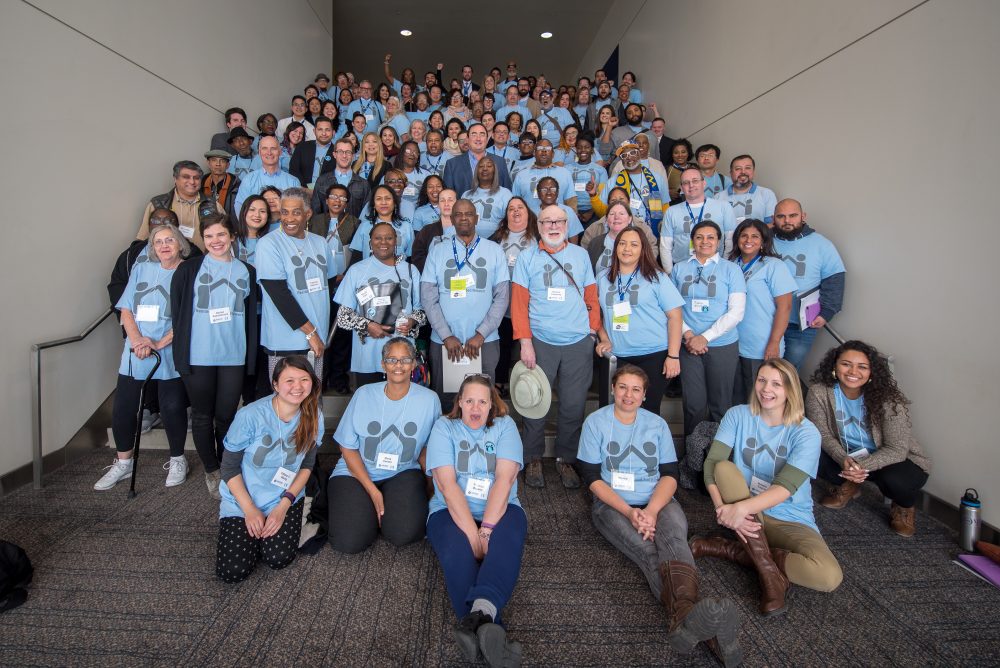



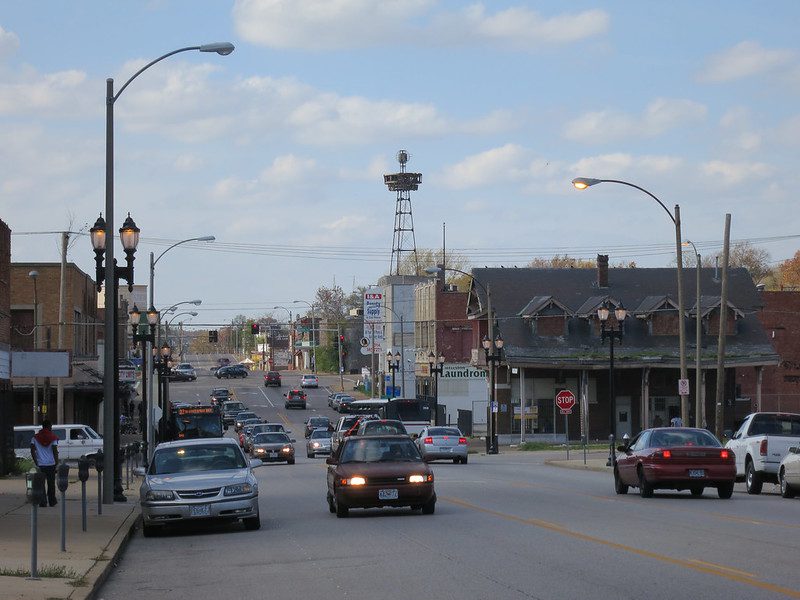
Comments